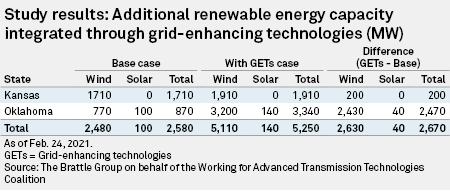Featured Topics
Featured Products
Events
S&P Global Offerings
Featured Topics
Featured Products
Events
S&P Global Offerings
Featured Topics
Featured Products
Events
S&P Global Offerings
Featured Topics
Featured Products
Events
Financial and Market intelligence
Fundamental & Alternative Datasets
Banking & Capital Markets
Economy & Finance
Energy Transition & Sustainability
Technology & Innovation
Podcasts & Newsletters
Financial and Market intelligence
Fundamental & Alternative Datasets
Banking & Capital Markets
Economy & Finance
Energy Transition & Sustainability
Technology & Innovation
Podcasts & Newsletters
24 Feb, 2021

By Zack Hale
The U.S. can wring more capacity out of existing electric transmission systems and help unlock stalled renewable energy projects by deploying grid-enhancing technologies, according to a new report.
The Feb. 24 report, developed by the consulting firm The Brattle Group on behalf of the Working for Advanced Transmission Technologies, or WATT, Coalition, found that widespread deployment of three such technologies on a national scale could produce $5 billion in annual energy cost savings while reducing carbon emissions by 90 million tons per year.
As case studies, the report examined the potential impact of dynamic line ratings, topology optimization software, and advanced power flow controllers in Oklahoma and Kansas, two states situated within the Southwest Power Pool's 14-state footprint.
Renewables integration more than doubled
While SPP has approximately 100 GWs of renewable energy capacity in its interconnection queue, the report limited its analysis to approximately 9 GWs of renewable energy resources in SPP that have already signed interconnection agreements within Oklahoma and Kansas but have yet to connect to the system, Jay Caspary, a former SPP transmission planner, explained during a Feb. 24 virtual event.
Caspary, who now serves as vice president of Grid Strategies, a pro-transmission group, said the WATT Coalition selected the states of Kansas and Oklahoma because SPP staff in 2019 identified significant grid congestion in those states. Developers seeking to connect generating resources to the power grid are typically required to pay for studies and upgrades needed to alleviate related grid constraints.
Using snapshots of actual SPP operations in 2019 and 2020, the report's authors were able to model SPP's projected operations in 2025 while accounting for approved transmission upgrades, new generation projects and retirements, and changes in load patterns. As part of the analysis, they sequentially modeled how much more of the stalled 9 GWs of renewable energy capacity could be unlocked by sequentially deploying dynamic line ratings, topology optimization software, and advanced power flow controllers to boost existing transmission capacity.

Dynamic line ratings rely on advanced sensors to adjust a power line's rated transmission capacity based on real-time data like weather conditions, potentially allowing less wind capacity to be curtailed during cold weather conditions. Topology optimization software can be used to transfer power flows from overloaded lines to other parts of the transmission system while maintaining reliability criteria. And advanced power controllers allow system operators to adjust a transmission line's impedance to increase or decrease power flows.
Taken together, the report found that the sequential deployment of the three technologies would enable more than twice the amount of additional renewable energy integration compared to a business-as-usual approach. The payback period on the initial $90 million in upfront costs to deploy the technologies in Oklahoma and Kansas would be about half a year, according to the report. Estimated annual carbon emission reductions were projected to total more than 3 million tons.
To arrive at its nationwide figures, the report's authors extrapolated the state-level results on a national scale. The report was funded by GridLab, EDF Renewables Inc. North America, NextEra Energy Inc. subsidiary NextEra Energy Resources LLC, and Duke Energy Corp. subsidiary Duke Energy Renewables LLC.
'So much more that needs to be done'
U.S. Rep. Kathy Castor, D-Fla., who chairs the House Select Committee on the Climate Crisis, noted during the Feb. 24 event that the panel's comprehensive policy blueprint released last summer urges the Federal Energy Regulatory Commission to do more to support grid-enhancing technologies.
"Imagine what we can do if we deploy these technologies nationwide," Castor said. "That's the task ahead of us."
Utilities such as National Grid PLC subsidiary National Grid USA started deploying grid-enhancing technologies on its systems about a year ago, noted Rudolph Wynter, the company's chief operating officer for wholesale networks and capital delivery. But, he asserted, "there is so much more that needs to be done."
In March 2020, FERC proposed to overhaul its existing transmission incentives policies (RM20-10) to reward projects with economic and reliability benefits. But now-Chairman Richard Glick, a Democrat, dissented from that order on several grounds at the time, including what he described in a partial dissent as "tepid enthusiasm" for grid-enhancing technologies.
A final order on transmission incentives was abruptly struck from FERC's agenda in January before former Republican Chairman James Danly's last meeting with the gavel, but Glick has promised to make action on transmission a top priority.
FERC in November 2020 also proposed a new rule (RM20-16) that would effectively end static line ratings but stopped short of requiring dynamic line ratings, giving transmission owners the option of implementing them but not requiring that they do so.
During the Feb. 24 event, former FERC member Nora Brownell argued that FERC can also go beyond offering incentives for projects that otherwise may not align with utilities' capital-intensive business models. Holding a series of technical conferences on grid-enhancing technologies with participation from regional grid operators is one option, Brownell said.
Regional grid operators "should stand up in a technical conference and talk about what they're doing to provide the leadership that is necessary to get these [technologies] deployed quickly and to deal with the issue of the cost," Brownell asserted. "FERC is in a unique position, particularly because it clearly has the support of Congress and a lot of stakeholders who are committed to a carbon-free economy and more renewables, but also who want affordability, which is first and foremost on everybody's mind."